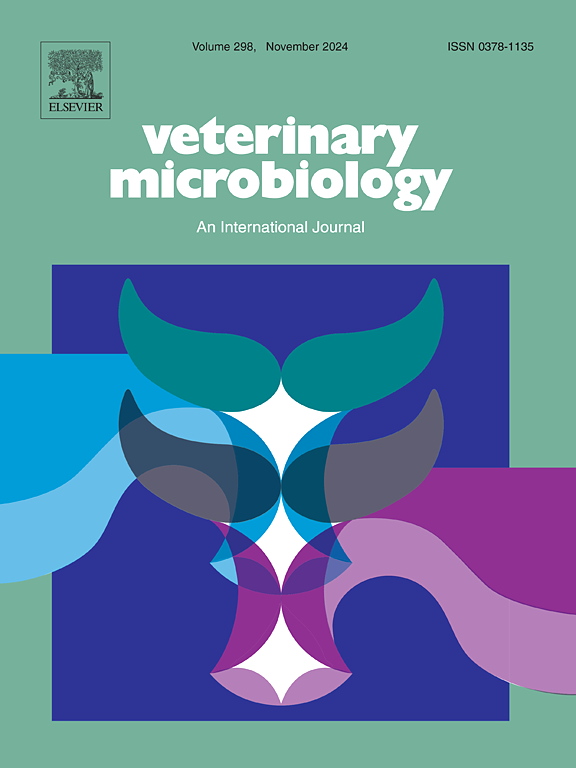NDM-5-plasmid diversity in multiple international high-risk Escherichia coli clones associated with canine and feline extraintestinal infections
IF 2.7
2区 农林科学
Q3 MICROBIOLOGY
引用次数: 0
Abstract
NDM-5-producing Escherichia coli are the predominant carbapenemase producers of medical and public health importance. The global spread of blaNDM-5-containing plasmids in high-risk E. coli clones has been primarily documented in humans and increasingly reported in animals and the environment. Here, we used whole-genome sequence analysis to describe the genetic diversity of 16 high-risk NDM-5-producing E. coli strains, with a variety of NDM-5 plasmids, isolated from dogs and cats with extraintestinal infections in Thailand between 2017 and 2021. The strains belonged to sequence type (ST) 410 (n = 8), ST354 (n = 3), ST648 (n = 2), ST361 (n = 1), ST617 (n = 1), and ST641 (n = 1). The ST641 strain carried blaNDM-5 on an IncX3 plasmid, while blaNDM-5 was localized on single-replicon or multi-replicon IncF plasmids in other STs. Non-conjugative F1:A1:B49 NDM-5 plasmids were limited to ST410 strains. They contained blaNDM-5 associated with the IS26-bounded complex class 1 integron (Int1) with dfrA17-aadA5-qacEΔ1-sul1 cassette array that shared similarities to nearly identical structures with the plasmids of ST410 strains from humans in Thailand and Myanmar. Conjugative IncFII (F2:A-:B-) NDM-5 plasmids containing Int1 with dfrA12-aadA2-qacEΔ1-sul1 cassette array were present in ST354 and ST648, and heterogeneous plasmid STs of conjugative multi-replicon IncF NDM-5 plasmids were found in ST361, ST410, ST617, and ST648. The blaNDM-5 elements mobilized by IS26 were shared among various IncF plasmids in high-risk E. coli clones but were conserved within the endemic E. coli ST410, representing the predominant lineage in Southeast Asian countries. Dogs and cats can develop infections with NDM-5-producing E. coli, posing the risk of further disseminating carbapenemase in veterinary settings and the community. This emphasizes the need to implement infection control and antimicrobial resistance surveillance programs in veterinary settings.
与犬和猫肠外感染相关的多个国际高危大肠杆菌克隆的ndm -5质粒多样性
生产ndm -5的大肠杆菌是主要的碳青霉烯酶生产者,对医疗和公共卫生具有重要意义。含有blandm -5的质粒在高风险大肠杆菌克隆中的全球传播主要在人类中有记录,在动物和环境中也有越来越多的报道。在这里,我们使用全基因组序列分析来描述2017年至2021年间从泰国肠外感染的狗和猫中分离出的16种具有多种NDM-5质粒的产生NDM-5的高风险大肠杆菌菌株的遗传多样性。菌株属于序列类型(ST) 410 (n = 8),ST354 (n = 3),ST648 (n = 2),ST361 (n = 1),ST617 (n = 1),和ST641 (n = 1)。ST641菌株在IncX3质粒上携带blaNDM-5,而在其他STs中blaNDM-5定位在单复制子或多复制子IncF质粒上。非共轭F1:A1:B49 NDM-5质粒仅限于ST410菌株。它们含有与is26结合的1类整合子(Int1)相关的blaNDM-5,具有dfrA17-aadA5-qacEΔ1-sul1盒式阵列,与来自泰国和缅甸的ST410人类菌株的质粒具有几乎相同的结构相似性。在ST354和ST648中存在含有Int1的共轭IncFII (F2:A-:B-) NDM-5质粒(dfrA12-aadA2-qacEΔ1-sul1盒阵列),在ST361、ST410、ST617和ST648中存在共轭多复制子IncF NDM-5质粒的异质性质粒STs。IS26动员的blaNDM-5元件在高风险大肠杆菌克隆的各种IncF质粒中共享,但在代表东南亚国家主要谱系的地方性大肠杆菌ST410中保守。狗和猫可感染产生ndm -5的大肠杆菌,造成在兽医机构和社区进一步传播碳青霉烯酶的风险。这强调了在兽医环境中实施感染控制和抗微生物药物耐药性监测规划的必要性。
本文章由计算机程序翻译,如有差异,请以英文原文为准。
求助全文
约1分钟内获得全文
求助全文
来源期刊

Veterinary microbiology
农林科学-兽医学
CiteScore
5.90
自引率
6.10%
发文量
221
审稿时长
52 days
期刊介绍:
Veterinary Microbiology is concerned with microbial (bacterial, fungal, viral) diseases of domesticated vertebrate animals (livestock, companion animals, fur-bearing animals, game, poultry, fish) that supply food, other useful products or companionship. In addition, Microbial diseases of wild animals living in captivity, or as members of the feral fauna will also be considered if the infections are of interest because of their interrelation with humans (zoonoses) and/or domestic animals. Studies of antimicrobial resistance are also included, provided that the results represent a substantial advance in knowledge. Authors are strongly encouraged to read - prior to submission - the Editorials (''Scope or cope'' and ''Scope or cope II'') published previously in the journal. The Editors reserve the right to suggest submission to another journal for those papers which they feel would be more appropriate for consideration by that journal.
Original research papers of high quality and novelty on aspects of control, host response, molecular biology, pathogenesis, prevention, and treatment of microbial diseases of animals are published. Papers dealing primarily with immunology, epidemiology, molecular biology and antiviral or microbial agents will only be considered if they demonstrate a clear impact on a disease. Papers focusing solely on diagnostic techniques (such as another PCR protocol or ELISA) will not be published - focus should be on a microorganism and not on a particular technique. Papers only reporting microbial sequences, transcriptomics data, or proteomics data will not be considered unless the results represent a substantial advance in knowledge.
Drug trial papers will be considered if they have general application or significance. Papers on the identification of microorganisms will also be considered, but detailed taxonomic studies do not fall within the scope of the journal. Case reports will not be published, unless they have general application or contain novel aspects. Papers of geographically limited interest, which repeat what had been established elsewhere will not be considered. The readership of the journal is global.
 求助内容:
求助内容: 应助结果提醒方式:
应助结果提醒方式:


